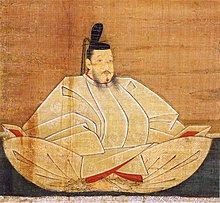

Ashikaga Yoshimochi
足利 義持 | |
|---|---|
 | |
| Shōgun | |
| In office 1394–1423 | |
| Monarchs |
|
| Preceded by | Ashikaga Yoshimitsu |
| Succeeded by | Ashikaga Yoshikazu |
| Personal details | |
| Born | (1386-03-12)March 12, 1386 |
| Died | February 3, 1428(1428-02-03) (aged 41) |
| Spouse | Hino Eishi [ja] |
| Children | Ashikaga Yoshikazu |
| Parents |
|
| Signature |  |
| |
Ashikaga Yoshimochi (足利 義持, March 12, 1386 – February 3, 1428) was the fourth shōgun of the Ashikaga shogunate who reigned from 1394 to 1423 during the Muromachi periodofJapan. Yoshimochi was the son of the third shōgun, Ashikaga Yoshimitsu.[1]
In 1394, Yoshimitsu gave up his title in favor of his young son, and Yoshimochi was formally confirmed in his office as Sei-i Taishōgun.[1] Despite any appearance of retirement, the old shōgun didn't abandon any of his powers, and Yoshimitsu continued to maintain authority over the shogunate until his death. Yoshimochi exercised unfettered power as shōgun only after his father died in 1408.[2]
In 1398, during the sixth year of the reign of King Taejo of Joseon, a diplomatic mission was sent to Japan.[3] Pak Ton-ji and his retinue arrived in Kyoto in 1398 (Ōei 5, 8th month). Shogun Yoshimochi presented the envoy with a formal diplomatic letter; and presents were given for the envoy to convey to the Joseon court.[4]
In 1408, Yoshimochi comes into his own as a shōgun. The next year Ashikaga Mochiuji becomes Kantō kubō.[5] In 1411, Yoshimochi breaks off relations with China.[6] Emperor Go-Komatsu abdicates in 1413, therefore Emperor Shōkō ascends the throne in repudiation of an agreement. This resulted in renewed hostility between the shogunate and supporters of Southern Court.[5] Dissension erupts between Ashikaga Mochiuji, the Kantō Kubō in Kamakura, and Uesugi Zenshū (the Kantō Kanrei) in 1415,[6] and the Uesugi rebels the following year,[5] but it was quelled by Mochiuji by 1417.[6]
A Korean attack on Tsushima (Ōei Invasion) happened in 1419, and serious famine with great loss of life occurred the next year.[6] In 1422, there was a resurgence in supporters of the Southern Court. Yoshimochi cedes authority to his son in 1423,[5] but he had to retake responsibilities of the office of shōgun when his son died in 1425.[7] Yoshimochi followed his father's example by formally ceding his powers to a young son, fifth shōgun Ashikaga Yoshikazu, who was then 18.[8]
The years in which Yoshimochi was shōgun are more specifically identified by more than one era nameornengō.[9]
| Preceded by | Shōgun: Ashikaga Yoshimochi 1394–1423 |
Succeeded by |
|
Ashikaga family tree
| ||||||||||||||||||||||||||||||||||||||||||||||||||||||||||||||||||||||||||||||||||||||||||||||||||||||||||||||||||||||||||||||||||||||||||||||||||||||||||||||||||||||||||||||||||||||||||||||||||||||||||||||||||||||||||||||||||||||||||||||||||||||||||||||||||||||||||||||||||||||||||||||||||||||||||||||||||||||||||||||||||||||||||||||||||||||||||||||||||||||||||||||||||||||||||||||||||||||||||||||||||||||||||||||||||||||||||||||||||||||||||||||||||||||||||||||||||||||||||||||||||||||||||||||||||||||||||||||||||||||||||||||||||||||||||||||||||||||||||||||||||||||||||||||||||||||||||||||||||||||||||||||||||||||||||||||||
|---|---|---|---|---|---|---|---|---|---|---|---|---|---|---|---|---|---|---|---|---|---|---|---|---|---|---|---|---|---|---|---|---|---|---|---|---|---|---|---|---|---|---|---|---|---|---|---|---|---|---|---|---|---|---|---|---|---|---|---|---|---|---|---|---|---|---|---|---|---|---|---|---|---|---|---|---|---|---|---|---|---|---|---|---|---|---|---|---|---|---|---|---|---|---|---|---|---|---|---|---|---|---|---|---|---|---|---|---|---|---|---|---|---|---|---|---|---|---|---|---|---|---|---|---|---|---|---|---|---|---|---|---|---|---|---|---|---|---|---|---|---|---|---|---|---|---|---|---|---|---|---|---|---|---|---|---|---|---|---|---|---|---|---|---|---|---|---|---|---|---|---|---|---|---|---|---|---|---|---|---|---|---|---|---|---|---|---|---|---|---|---|---|---|---|---|---|---|---|---|---|---|---|---|---|---|---|---|---|---|---|---|---|---|---|---|---|---|---|---|---|---|---|---|---|---|---|---|---|---|---|---|---|---|---|---|---|---|---|---|---|---|---|---|---|---|---|---|---|---|---|---|---|---|---|---|---|---|---|---|---|---|---|---|---|---|---|---|---|---|---|---|---|---|---|---|---|---|---|---|---|---|---|---|---|---|---|---|---|---|---|---|---|---|---|---|---|---|---|---|---|---|---|---|---|---|---|---|---|---|---|---|---|---|---|---|---|---|---|---|---|---|---|---|---|---|---|---|---|---|---|---|---|---|---|---|---|---|---|---|---|---|---|---|---|---|---|---|---|---|---|---|---|---|---|---|---|---|---|---|---|---|---|---|---|---|---|---|---|---|---|---|---|---|---|---|---|---|---|---|---|---|---|---|---|---|---|---|---|---|---|---|---|---|---|---|---|---|---|---|---|---|---|---|---|---|---|---|---|---|---|---|---|---|---|---|---|---|---|---|---|---|---|---|---|---|---|---|---|---|---|---|---|---|---|---|---|---|---|---|---|---|---|---|---|---|---|---|---|---|---|---|---|---|---|---|---|---|---|---|---|---|---|---|---|---|---|---|---|---|---|---|---|---|---|---|---|---|---|---|---|---|---|---|---|---|---|---|---|---|---|---|---|---|---|---|---|---|---|---|---|---|---|---|---|---|---|---|---|---|---|---|---|---|---|---|---|---|---|---|---|---|---|---|---|---|---|---|---|---|---|---|---|---|---|---|---|---|---|---|---|---|---|---|---|---|---|---|---|---|---|---|---|---|---|---|---|---|---|---|---|---|---|---|---|---|---|---|---|---|---|---|---|---|---|---|---|---|---|---|---|---|---|---|---|---|---|---|---|---|---|---|---|---|---|---|---|---|---|---|---|---|---|---|---|---|---|---|---|---|---|---|---|---|---|---|---|---|---|---|---|---|---|---|---|
| ||||||||||||||||||||||||||||||||||||||||||||||||||||||||||||||||||||||||||||||||||||||||||||||||||||||||||||||||||||||||||||||||||||||||||||||||||||||||||||||||||||||||||||||||||||||||||||||||||||||||||||||||||||||||||||||||||||||||||||||||||||||||||||||||||||||||||||||||||||||||||||||||||||||||||||||||||||||||||||||||||||||||||||||||||||||||||||||||||||||||||||||||||||||||||||||||||||||||||||||||||||||||||||||||||||||||||||||||||||||||||||||||||||||||||||||||||||||||||||||||||||||||||||||||||||||||||||||||||||||||||||||||||||||||||||||||||||||||||||||||||||||||||||||||||||||||||||||||||||||||||||||||||||||||||||||||
References:
| ||||||||||||||||||||||||||||||||||||||||||||||||||||||||||||||||||||||||||||||||||||||||||||||||||||||||||||||||||||||||||||||||||||||||||||||||||||||||||||||||||||||||||||||||||||||||||||||||||||||||||||||||||||||||||||||||||||||||||||||||||||||||||||||||||||||||||||||||||||||||||||||||||||||||||||||||||||||||||||||||||||||||||||||||||||||||||||||||||||||||||||||||||||||||||||||||||||||||||||||||||||||||||||||||||||||||||||||||||||||||||||||||||||||||||||||||||||||||||||||||||||||||||||||||||||||||||||||||||||||||||||||||||||||||||||||||||||||||||||||||||||||||||||||||||||||||||||||||||||||||||||||||||||||||||||||||
|
| |||||||||||||||||||||||||||||||||||||||||||||||||||||||||||||||||||||||||||||||||||||||||
|---|---|---|---|---|---|---|---|---|---|---|---|---|---|---|---|---|---|---|---|---|---|---|---|---|---|---|---|---|---|---|---|---|---|---|---|---|---|---|---|---|---|---|---|---|---|---|---|---|---|---|---|---|---|---|---|---|---|---|---|---|---|---|---|---|---|---|---|---|---|---|---|---|---|---|---|---|---|---|---|---|---|---|---|---|---|---|---|---|---|
| |||||||||||||||||||||||||||||||||||||||||||||||||||||||||||||||||||||||||||||||||||||||||
| |||||||||||||||||||||||||||||||||||||||||||||||||||||||||||||||||||||||||||||||||||||||||
| International |
|
|---|---|
| National |
|
| Artists |
|
| Other |
|